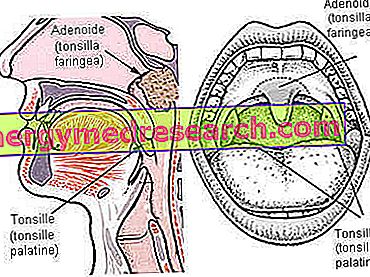Generality
The tonsils are lymph gland organs located at the level of the mouth and pharynx. The term lymph gland means an organ having an anti-infective and immune function;

The tonsils are distributed in different areas, between the oral cavity and the pharynx, therefore, they are identified by different names based on their position; we have in particular:
- the palatine tonsils, in number of two (in common language, when we speak of tonsils in general we mean the palatine tonsils);
- the pharyngeal tonsil (rino) (in common parlance, it is often called adenoid, and when it appears inflamed, then enlarged, we speak of adenoids);
- lingual tonsil .
Anatomy of the tonsils
The tonsils are conspicuous agglomerates of lymphoid tissue, so much so that they can be considered real organs. At the pharyngeal level, for greater completeness of information, areas with such densities alternate with less dense areas of lymphoid tissue (at this level we speak specifically of adenoid tissue ).

The palatine tonsil forms an ovoid mass. Shape and size are reminiscent of an almond and this explains why it is also known as amygdala, a term of Greek origin that indicates almond. In the human body there are two palatine tonsils, which lodge symmetrically in a region called the isthmus of the jaws . This area connects the mouth and pharynx; it is formed by arched structures and, on the sides of them, are the palatine tonsils.
Given their position, the palatins are the only visible tonsils. The precise dimensions of a single palatine tonsil may vary from individual to individual; the average data show these measures:
- height: 20-25 mm.
- length: about 15 mm.
- thickness: about 10 mm.
The surface of the palatine tonsil is coated by the pharyngeal mucosa. The mucosa is the portion of tissue in direct contact with the lumen of the animal hollow organs. The epithelium that covers the pharyngeal mucosa is classified as stratified pavement, ie formed by overlapping flattened cells. Through histological analysis of the tonsillar epithelium cavities can be noted, called crypts, also very deep. These structures allow to widen the contact surface with what penetrates from the outside into the oral cavity, allowing a more efficient action against germs and bacteria. Inside the crypts, in fact, the mucous secretion containing the cells of the immune system is collected.
The pharyngeal tonsil is found at the level of the nasopharynx, that is the upper part of the pharynx, between the pharyngeal vault and the upper face of the palate. It is also called amygdala (pharyngeal in this case) by virtue of its shape, similar to that of an almond; more commonly it is known as an adenoid . In the same way as the palatal tonsil, its histological structure includes the presence of crypts. It is a particular organ: after birth it develops progressively until the 7th and 8th year, at which time it begins to atrophy naturally and almost disappear, in some cases, into adulthood.
The lingual tonsil is located behind and at the base of the tongue. This area is covered by follicular agglomerates, that is by lymphoid tissue, between which circular furrows penetrate. The tonsil crypts, about 2-3 mm deep, are contained in these grooves. Like the pharyngeal tonsil, also the lingual one undergoes a process of involution starting from the age of about 14 years. Around the age of 20, the reduction of the lingual tonsil is complete, so that only a few small follicles remain.
Tonsil functions
The tonsils, together with other local lymphoid clusters (small islands of lymphatic tissue that connect them together), constitute Waldeyer's lymphatic ring .
Because of their position, located at the beginning of the respiratory and digestive tracts, and for their lymphoid composition, the tonsils play a very precise role: they are the first defense barriers against germs and bacteria that penetrate from the outside, through the air and food substances. The anti-infective and immune action is favored by the presence of crypts. The reasons are two:
- Invaginations, or cavities, increase the contact surface between tonsillar epithelium and external pathogens. In this way, the anti-infective action is more efficient.
- The epithelium of the crypts produces a lymphocytic infiltration inside the crypt. This guarantees an antigen-antibody type immune reaction.
Tonsils are particularly active in children until puberty.
Tonsil disorders
The pathologies are indicated with the generic term of tonsillitis. They affect the lymphoid tissue of the tonsils, giving rise to inflammation.
More precisely we talk about:
- Tonsillitis, when inflammation affects the palatine and lingual tonsils.
- Adenoiditis, when inflammation affects the pharyngeal tonsil.
Furthermore, the tonsillitis should be divided into:
- Acute palatine tonsillitis:
- Acute catarral tonsillitis
- Streptococcal tonsillitis
- Parenchymatous tonsillitis
- Peritonsillar abscess
- Acute lingual tonsillitis:
- Acute catarrhal lingual tonsillitis
- Suppurative lingual tonsillitis
For adenoiditis, one speaks only of acute adenoiditis .

Acute palatine tonsillitis and acute catarral lingual are generally consequent to cases of cooling. The peritonsillar abscess is an exception, for which we speak of poor oral hygiene. They are all caused by bacterial proliferation (streptococcus, pneumococcus and staphylococcus) locally, usually in crypts. You can observe, in those who contract these inflammations, symptoms such as: fever, cough, pain in swallowing, hypertrophy (ie swelling) of the tonsils and yellowing of the tonsillar tissue. Suppurative lingual tonsillitis, on the other hand, is caused by a foreign body.
Acute adenoiditis deserves more attention, as it usually affects infants and young children. In fact, starting at 12-14 years of age, the pharyngeal tonsil begins an involution process. The triggering cause is the proliferation of germs at the level of the nasopharynx, following cooling. The most significant symptom is the difficulty in breathing, more intense in infants than in children.
Finally, a pathological condition that is not serious, as it is of non-bacterial origin, is cryptic-caseous halitosis . It occurs on the palatine tonsils and affects adolescents the most for a reason closely related to the process of atrophy of the tonsils: in fact, the reduction of lymphoid tissue does not correspond to a simultaneous reduction of the scaffolding of the crypts. As a result, the crypts are empty and the food lurks inside. This is followed by a process of putrefaction, which is manifested by bad breath. The tonsils become yellowish, but the symptoms of pain and fever are absent.



